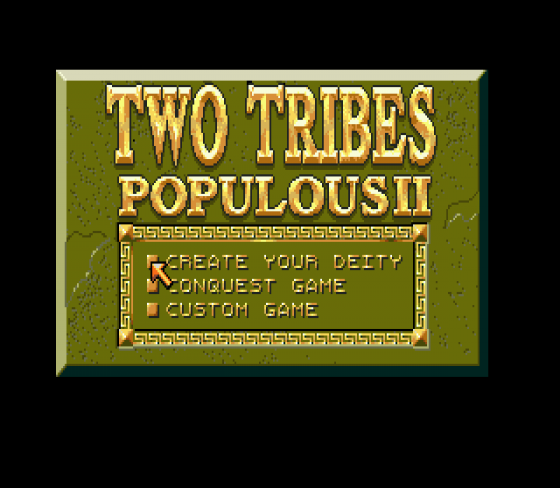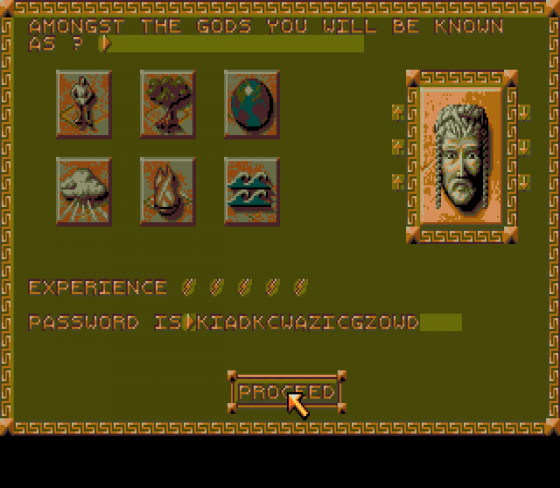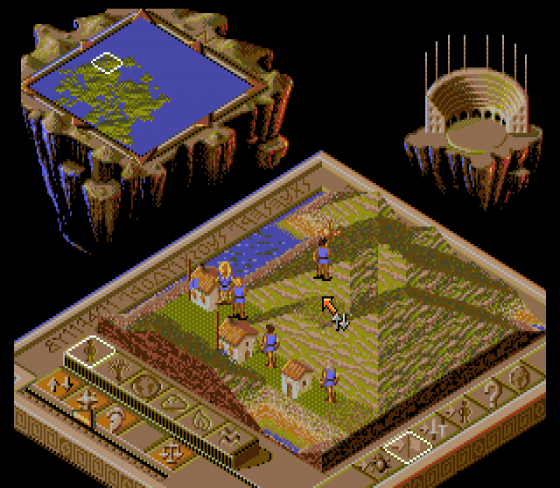
Mean Machines Sega
 1st August 1993
1st August 1993
Publisher: Virgin Games
Machine: Sega Mega Drive (EU Version)
Published in Mean Machines Sega #11
How To Play
Defeat the enemy by having more followers and mana on each of 1,000 levels. 'Build' your god by allocating powers.
Two Tribes: Populous II
So you're a Manichaeist? Well, you are if you play Populous II. Manichaeism is an ancient religion, based around the prophets Manichae and Zoroastrian. It's a simple philosophy - the universe is a balance of two forces; good and evil. Both forces are in constant battle, using the physical elements and the spiritual souls of creation to dominate each other.
The most important precept of all is that nothing is certain. Good's victory over evil is not a foregone conclusion. As the deity of goodness, it's your job in Populous II to ensure that you win, by crushing your opposition. Your followers are devoted and will die for you in battle. There may be no need for that if you are a god of the big league - you can bring down fire, brimstone and calamity on your enemy, while your people prosper. Prepare for a battle across 1,000 worlds.
Heal The World
Homesteads
Settlements range from tiny farmhouses, to huge Roman citadels. In the privacy of their settlements the people are reproducing (!). Each houses a certain amount of settlers. When the house is full, a settler is ejected ('sprogged') and searches for new ground to build on. This is how your people spread across the land, and why you must constantly provide land for them.
The rate at which settlers reproduce is determined by the tech level of the settlement, which you can check with the question mark icon.
Papal Bull
Homage
You customise your god as you win levels. Depending on the scale of your victory, you are awarded a number of experience points. These are placed in one of the six disaster categories described later. You give your god a name and may alter his physical representation. A password is given so you can develop your chosen deity.
Winning With Mana
Developing your people is only half the story. You have a duty to annihilate the enemy, and Mana is your means of doing it. As your followers grow in number, they each provide you with a steady supply of power, or Mana. This Mana is turned into disasters by you, and visited upon the enemy. On each world there are certain disasters allowed, certain prohibited. Disasters fall into four elemental categories. Here is a selection of the twenty odd disasters.
-
Fire: Pillar Of Fire
The pillar erupts within a selected area, and travels randomly. It wastes cultivated land, destroys settlements and burns alive anyone it encounters. -
Water: Baptismal Font
When placed, fonts become permanent features. Anyone who falls in changes his alignment - good to bad or vice versa. Useful for creating a toe-hold in the depths of enemy territory. -
Earth: Swamps
Once placed, swamps remain. Cropland is lost, and anyone who falls into them is similarly doomed. On some dry landscapes, swamps are non-permanent.
Crusaders
You have the power to convert your leader into a super-human creature of mythology. He then travels through enemy territory, destroying anything in his path, until his battles overwhelm him. If your ordinary settlers encounter the enemy, they embark on a fight to the death.
The Levellers
The basis of Populous is the flattening of land. Most land is naturally bumpy. You have the power to raise or lower land, making level areas. If a person, a 'settler', comes across a flat area, he will create a settlement. The size and type of settlement depends on how large the clear area is.
Some areas cannot be cultivated - if the land has been scorched, if it has rocks, or has been turned to swamp.Gus
Populous was brilliant as ideas go, but had some shortcomings. This sequel has much the same basic gameplay. It's a bit like PGA 2 to PGA - just tweakings and extra features, but the tweaks do make it a much better game.
There are double the amount of levels than in the original; the graphics are clearer; and the disasters are more interesting. In Populous, you could use every disaster at the start of the game, which meant there was nothing new to discover.
In Populous II you start with only one disaster power, and learn more as you customise your god. The only area where little improvement has been made is the sound, which is still poor.Although Populous is a little eclipsed by Mega-Lo-Mania, I'm still well pleased with this excellent updated.
Rich
I remember buying the first Populous game many moons ago on the Amiga and fondly recall that first day I played it - it was brilliant. However, by day two I'd completely gone off the game. Why? The gameplay was just too repetitive - you did the same things on each level and I got bored. Quickly.
However, Populous II goes a long way to making up for the original game. Although the basic idea of each level is exactly the same, there's plenty more in the way of variety with the player having to work his way up with experience points to glean and extra disasters to make use of.
The computer player starts off as a bit of a thicko, but a few levels in it's a lot tougher, making play a lot more enjoyable. As Gus says, Mega-Lo-Mania is a tad better. However, if you really enjoyed the original game, you'll go bananas over this one.
Verdict
Presentation 89%
P. A custom game option that allows you to affect every level parameter. Good control system and screen layout.
N. Long password system.
Graphics 81%
P. The settlement graphics are neat and nicely done. It's easy to see what's going on despite the small scale. Some spectacular disasters.
Sound 45%
N. No music and only occasional samples of screams and battles. Most of the game is played in silence.
Playability 87%
P. Populous II has a good 'board-game' feel, helped by the easy rules, and seeing your progress rewarded.
N. Some of the early levels are very easy, but time-consuming. The gameplay may be too passive for some.
Lastability 89%
P. 1000 levels, with some biggie effects, like Tidal Waves to look forward to. Evil soon starts to play a smart game.
N. The only changes between levels are tactics, speed and landscape.
Overall 89%
Populous II is a clever reworking of a classic game. It will only appeal to a section of Megadrive owners, but they'll find an excellent strategy product.
Scores
Sega Mega Drive Version| Presentation | 89% |
| Graphics | 81% |
| Sound | 45% |
| Playability | 87% |
| Lastability | 89% |
| Overall | 89% |





